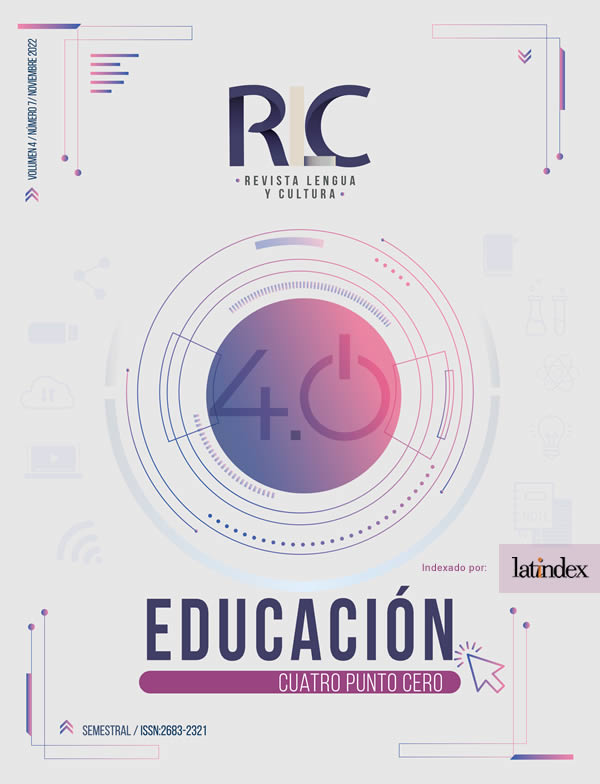Promoting Transcultural Reflection in the French Class through an emblematic Painting by a contemporary Acadian Artist
Abstract
The use of a foreign language as way to communicate is becoming more frequently in the globalized world where we live. Therefore, the acquisition of a language different from the mother tongue is important to maintain interpersonal and professional relationships with others (Uribe, et. al. 2008). According to Rojas et. al. (2019) reaching a good development of the communicative competence in English is important for the professional development, so, it exists the need to focus the attention on the English teaching and learning processes and the development of the communicative abilities. The development of the oral communication in English requires the implementation of specific methodologies that consider different factors and adapt to the needs of each student in the classroom. The main objective of this paper is presenting a brief literature review that suggests the implementation of the translanguaging as a pedagogy with the purpose of developing oral communicative competence in English. The overall findings of this literature review show the main characteristics of translanguaging, it benefits, and some strategies and activities that can be implemented in bilingual classrooms. Further research in this topic will include the implementation of an action research project that implements translanguaging pedagogy in a bilingual elementary school.
Downloads
Literaturhinweise
[2] Baker, C. (2003). Biliteracy and transliteracy in Wales: Language planning and the Welsh national curriculum. Continua of Biliteracy. Multilingual Matters.
[3] Baker, C. (2011). Foundations of bilingual education and bilingualism. Multilingual Matters.
[4] Canagarajah, S. (2011). Codemeshing in academic writing: Identifying teachable strategies of translanguaging. The Modern Language Journal, 95(3), 401- 417. https://doi.org/10.1111/j.1540-4781.2011.01207.x
[5] Cenoz, J y Gorter, D. (2020). Teaching English through pedagogical translanguaging. World Englishes, 39(2), 300-311. https://doi.org/10.1111/weng.12462
[6] Di Virgilio, A. (2020). Translenguaje: derribando barreras en el aula de lenguas extranjeras. Revista Digital de Políticas Lingüísticas (RDPL), (13), 06-33. https://revistas.unc.edu.ar/index.php/RDPL/article/view/31529
[7] Fundora, D y Llerena, O. (2018). Características de las habilidades comunicativas en idioma inglés en estudiantes del curso introductorio de lengua inglesa. Tzhoecoen, 10(2), 227-238. https://doi.org/10.26495/rtzh1810.226317
[8] García, O. (2009). Education, Multilingualism and Translanguaging in the 21st Century. Skutnabb-Kangas, T., Phillipson, R., Mohanty, A. y Panda, M (Eds.), Social Justice through Multilingual Education (pp. 140- 158). Multilingual Matters.
[9] García, O y Lin, A. (2017). Translanguaging in bilingual education. Bilingual and multilingual education. http://www.cana1.com/uploads/1/2/0/8/120881056/bilingual.pdf#page=134
[10] García, O., & Wei, L. (2018). Translanguaging. The Encyclopedia of Applied Linguistics. Hoboken.
[11] Jackson, F. (2020). Aportaciones de las estrategias didácticas en el desarrollo de la competencia comunicativa. Revista de Educación, (20), 185-204. http://fh.mdp.edu.ar/revistas/index.php/r_educ/article/view/4171/4134
[12] Lewis, G., Jones, B. & Baker, C. (2012a). Translanguaging: Origins and development from school to street and beyond. Educational Research and Evaluation, 18, 641–54. https://doi.org/10.1080/13803611.2012.718488
[13] Maciel, R. y Ferrari, L. (2019). Miradas situadas sobre translenguaje en una escuela en la frontera Brasil-Bolivia. Raído, 13(33), 102–122. https://doi.org/10.30612/raido.v13i33.9933
[14] Medina, J. P. (2011). El efecto escuela. más allá del aula. REICE. Revista Iberoamericana sobre Calidad, Eficacia y Cambio en Educación, 9(1), 28-45. https://www.redalyc.org/pdf/551/55118790003.pdf
[15] Ordóñez, C. (2012). Educación para el bilingüismo y aprendizaje de maestros: comprensión del desempeño auténtico en la acción de cambiar prácticas pedagógicas. Revista Folios, (36), 3-22. https://www.redalyc.org/articulo.oa?id=345932039001
[16] Portolés, L. y Martí, O. (2017) Translanguaging as a teaching resource in early language learning of English as an additional language (EAL). Bellaterra Journal of Teaching & Learning Language & Literature, 10(1),61-77. https://raco.cat/index.php/Bellaterra/article/view/321507/412095
[17] Rojas, O., Barceló, G., Godínez, O. (2019). La comunicación oral en inglés para la formación del profesional: Retos y contradicciones. Opuntia Brava, 11(4), 199- 207. https://opuntiabrava.ult.edu.cu/index.php/opuntiabrava/issue/view/49
[18] Uribe, D., Gutiérrez, J. y Madrid, D. (2008). Las actitudes del alumnado hacia el aprendizaje del inglés como idioma extranjero: estudio de una muestra en el sur de España. Porta Linguarum: revista internacional de didáctica de las lenguas extranjeras, (10), 85- 100. http://dx.doi.org/10.30827/Digibug.31782
[19] Wei, L. (2017). Translanguaging and the goal of TESOL. https://www.tesol.org/docs/default-source/ppt/li-wei.pdf
[20] Williams, C. (2002). A Language Gained: A Study of Language Immersion at 11–16 Years of Age. Bangor: School of Education.
Copyright (c) 2022 Alejandra Fabiola Rivera, Nallely Garza Rodríguez

Dieses Werk steht unter der Lizenz Creative Commons Namensnennung - Nicht-kommerziell - Keine Bearbeitungen 4.0 International.













